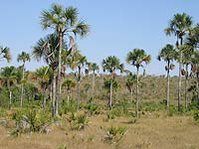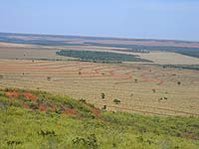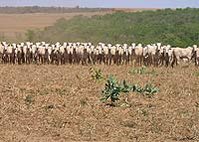Biological diversity in the Cerrado
Contents
- 1 Overview Map of the Cerrado. (Source: CI (Biological diversity in the Cerrado) /CABS)
- 2 Unique and Threatened Biodiversity
- 3 Human Impact
- 4 Conservation Action and Protected Area
- 5 NotesThis article is based on contributions from Gustavo Fonseca, Roberto Cavalcanti, Anthony Rylands, and Adriano Paglia.For a complete list of all contributors to the Biodiversity Hotspot program, see Biodiversity Hotspot Site Credits (Biological diversity in the Cerrado) .
- 6 Further Reading
Overview Map of the Cerrado. (Source: CI (Biological diversity in the Cerrado) /CABS)
The Cerrado spreads across 2,031,990 km2 of the central Brazilian Plateau. The second largest of Brazil's major biomes, after Amazonia, the hotspot accounts for a full 21 percent of the country's land area (it also extends marginally into Paraguay and Bolivia). The most extensive woodland/savanna region in South America, the Cerrado is also the only hotspot that consists largely of savanna, woodland/savanna and dry forest ecosystems. Within the region, there is a mosaic of different vegetation types, including tree and scrub savanna, grassland with scattered trees, and occasional patches of a dry, closed canopy forest called the cerradão. Gallery forests are found throughout the region, although they are technically not considered part of the typical Cerrado formations.
The hotspot actually receives abundant rainfall (between 1,100 and 1,600 millimeters per year), although this rainfall is concentrated in a six to seven month period between October and April. The rest of the year is characterized by a pronounced dry season, and many plant species in the hotspot are well adapted to drought conditions as a result. Much of the vegetation is also adapted to fire, which is an important part of the ecology of the Cerrado. The flora displays a number of adaptations to fire, including thick bark, leathery leaves, a rapid regeneration capacity and deep root systems. Adaptation to fire maintains a balance between grasses and woody vegetation and assists in nutrient recycling and germination.
Unique and Threatened Biodiversity
Plants
The Cerrado is one of the richest of all tropical savanna regions and has high levels of endemism. The region is home to an estimated 10,000 plant species, of which about 4,400 are endemic. Herbaceous species, which include herbs rather than woody plants, are almost entirely endemic. Some of the most remarkable plants in the Cerrado include the conspicuous Mauritia flexuosa palms (known locally as buritis) that grow along the swampy headwaters of streams and rivers, and the spectacular trees of the genus Tabebuia (of the family Bignoniaceae, and referred to as ipê), which have brilliant pink, yellow, white and purple flowers.
Vertebrates
Birds
The Cerrado has relatively high bird diversity, with more than 600 regularly occurring species, nearly 20 of which are endemic. The hotspot also contains two of BirdLife International’s Endemic Bird Areas. The endemics include the highly threatened blue-eyed ground dove (Columbina cyanopis, CR), the Minas Gerais tyrannulet (Phylloscartes roquettei, CR), known only from three areas in the São Francisco valley in north and central Minas Gerais, and the Brasília tapaculo (Scytalopus novacapitalis), a passerine that is found only in a few populations in gallery forest remnants near Brasilia, and a few locations in Minas Gerais, including the Serra da Canastra National Park. Some of the most distinctive birds in the hotspot include two very large species, the rhea (Rhea americana) and the red-legged seriema (Cariama cristata), neither of which are endemic.
Mammals
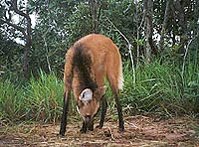 Photo of a maned wolf (Chrysocyon brachyurus) taken with a camera trap in the Cerrado. (© Conservation International, Photograph by Leandro Silveira)
Photo of a maned wolf (Chrysocyon brachyurus) taken with a camera trap in the Cerrado. (© Conservation International, Photograph by Leandro Silveira) There are nearly 200 species of mammal in the Cerrado, though only 14 are endemic. Four of the endemics are representatives of the three endemic genera in the hotspot: a rodent (Microakodontomys transitorius), known only from a single specimen collected in 1986 in the Brasília National Park; the Candango mouse (Juscelinomys candango), a semi-fossorial rodent first discovered in 1960 on the site of the capital, Brasília, then under construction, and which has never again been collected; and the cerrado mouse (Thalpomys cerradensis) and hairy-eared cerrado mouse (T. lasiotis). Until twenty thousand years ago, giant mammals, the so-called megafauna, were found in the Cerrado. Magnificent species, such as a giant armadillo, a giant sloth and a rhino-type animal lived together with primitive humans.
Many large mammals that range widely throughout South America have the Cerrado as one of their principal habitats. One of the best known of these species is the maned wolf (Chrysocyon brachyurus), a giant, large-eared, long-legged fox-like animal that can grow to 80 centimeters in height and weigh 23 kilograms. The wolf has golden-red fur, with a black stripe running from the top of its head to the middle of its back. Two of the most unusual species are the giant armadillo (Priodontes maximus, EN) and the giant anteater (Myrmecophaga tridactyla, VU), which as the largest anteater in the world can grow up to 1.9 meters in length from nose to base of tail, with a huge flag-like tail that can be up to a meter long.
Other large mammal species found in the Cerrado include the Brazilian tapir (Tapirus terrestris, VU) and the pampas deer (Ozotoceros bezoarcticus), and several cat species, such as the jaguar (Panthera onca), ocelot (Felis pardalis), and jaguarundi (Felis yagouaroundi).
Reptiles
More than 30 of the over 220 species of reptiles in the Cerrado are endemic, including six members of the snake genus Apostolepis. The genus Amphisbaena is well represented, with at least 26 species present. One of the best-known reptiles is the giant worm lizard (Amphisbaena alba), which can grow up to 70 centimeters in length, feeds on beetles, ants, and spiders, and has a clutch size ranging from 8-16 eggs, one of the largest known for the family. Half of the worm lizards are endemic to the region.
Amphibians
Nearly 200 species of amphibians have been recorded in the hotspot, more than 25 of which are endemic, including two species restricted to the Serra da Canastra National Park: the Canastra snouted tree frog (Scinax canastrensis) and the Zagaia tree frog (Hyla sazimai). Among the endemics are two highly threatened species: Hyla izecksohni (CR), known only from Rubião Júnior, Botucatu, in the state of São Paulo, and Odontophrynus moratoi (CR), known only from the type locality, Botucatu, also in São Paulo State and not collected since 1990.
Freshwater Fishes
Freshwater fish diversity is quite high in the Cerrado, with about 800 species, a quarter of which are endemic. The hotspot holds almost 250 genera of fish, nearly 20 of which are endemic.
Invertebrates
While little is known about the insect diversity of the Cerrado, preliminary data suggests that a quarter of the 40,000 species of Neotropical butterflies and moths, nearly a third of the more than 440 species of Neotropical termites and a quarter of the nearly 550 Neotropical social wasps are found here. In addition, there are more than 800 bee species (out of about 7,000 in the entire Neotropics).
Human Impact
The Cerrado has supported human populations for ten thousand years, first hunter-gatherers and later small-scale agricultural societies. Neither of these appears to have had a major impact on the integrity of the ecosystem. Beginning in the 16th century, colonization by Portuguese settlers focused mainly on the Brazilian coast, and the interior was once again spared any major development.
Today in Brazil there are still approximately 300,000 indigenous peoples, in more than 200 indigenous societies, the majority of whom reside in the North and Central-West. Of these, 38 ethnic groups still live in the Cerrado region, with a population of approximately 45 thousand people. These groups include the Krahô, Xavante, Xerente, Bororo, Karajá, Kayapó, and Canela. Among these groups the Avá-Canoeiro, Tapuya and Karajá are facing extinction, with less than 300 people remaining.
It was not until the 18th century that the first incursions of colonists began into the Cerrado, starting with settlers seeking gold and precious stones. These first settlements and their accompanying roads and railways opened the way for the development of cattle ranches. Ranches were the first major impact on the ecosystem and remained the primary economic activity in the Cerrado until the 1950s. After the 1970s, with the work of Empresa Brasileira de Pesquisa Agropecuária (EMBRAPA) in soil restoration, the Cerrado region was transformed into the most productive and competitive area for crop production in Brazil. Along with deep soils enhanced by fertilizers, this was also a result of low land prices and flat landscapes, which are good for mechanized agriculture.
In the 1950s, the Brazilian government decided to build a new capital city in the state of Goiás, in the core of the Cerrado. The construction of Brasilia, which was accompanied by large-scale highway development, was specifically designed to encourage movement into the interior of the country. New transportation infrastructure enabled the transport of cattle and agricultural products to markets from the region. The Cerrado became Brazil's new agricultural frontier in the 1970s and 1980s, with the establishment of many agricultural megaprojects like roads and hydropower plants. This was accompanied by an increase in population (Population growth rate) and trade development based in agricultural production, mainly soy and corn. In 2000, the Cerrado region was responsible for 35 percent of all crop production in Brazil. Currently, 58 percent of Brazil's total soy production comes from the Cerrado.
A quarter of all grain produced in Brazil is grown in the Cerrado, and there are nearly 40 million head of cattle, with steady growth projected in both industries, as well as in charcoal production. In total, 37.3 percent of the Cerrado has already been totally converted to human use, while an additional 41.4 percent is used for pasture and charcoal production. The gallery forests in the region have been among the most heavily affected. It is estimated that about 432,814 km2, or 21.3 percent of the original vegetation, remains intact today.
Conservation Action and Protected Area
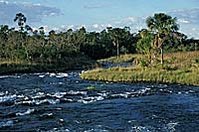 The Formoso River flows through Emas National Park. Covering 1,310 square kilometers, Emas National Park is one of the most important protected areas in the Cerrado. (© Conservation International, Photograph by Haroldo Castro)
The Formoso River flows through Emas National Park. Covering 1,310 square kilometers, Emas National Park is one of the most important protected areas in the Cerrado. (© Conservation International, Photograph by Haroldo Castro) Despite its large size and importance for biodiversity, the Cerrado is today poorly represented in Brazil's otherwise extensive protected areas system. The region's image as Brazil's agricultural frontier has meant less political will to establish additional parks and enforce stricter legislation. Only about 111,000 km2, or 5.5 percent of the total land area, is currently protected, and only around 28,500 km2 (1.4 percent) is conserved in protected areas in IUCN categories I to IV.
The most important protected areas in the Cerrado are the 7,290-km2 Nascentes do Parnaíba National Park, the 330 km2 Chapada dos Guimarães National Park, the 2,000- km2 Serra da Canastra National Park (although only about 720 km2 are actually protected), the 1,310-km2 Emas National Park and the 840-km2 Grande Sertão Veredas National Park. In 2001, a large and valuable area of the Cerrado in the State of Tocantins was protected as the 1,588- km2 Jalapão State Park. In recent years, private reserves, established under the Private Natural Heritage Reserve system, have become an important component of biodiversity protection in the Cerrado.
Emas National Park, which is currently threatened by the effects of large-scale agricultural activities that surround it, is the site of a partnership between Conservation International and the non-governmental organizations Oréades, Fundação Emas (FEMAS), Pró-Carnívoros, PEQUI, IBAMA and EMBRAPA, along with a group of universities including University of São Paulo, University of Brasília, University of São Carlos and the University of Goiás, are also part of the partnership. The neighboring municipalities and farming cooperatives and environmental agencies of Goiás, Mato Grosso and Mato Grosso do Sul are also involved in the conservation efforts to protect the landscape that includes important biodiversity and the headwaters of the three major Brazilian river systems that converge near the park.
In Grande Sertão Veredas, which was established in 1989, FUNATURA is working to better manage the protected area and protect it from growing agricultural threats using funds obtained through the first and only debt-for-nature swap ever approved for Brazil.
In the Cerrado, indigenous territories total three times the size of the protected area system, which shows how essential these [[region]s] are for biodiversity conservation.
In March 1998, a Regional Priority Setting Workshop for the Cerrado was held in Brasilia. The meeting participants identified 70 conservation priority areas and offered suggestions for immediate action. Participants indicated the use of legislative incentives for preservation of biodiversity and water sources. The workshop also recommended the consolidation of existing parks and reserves to create new protected areas. In addition, it identified the need for more intensive faunal and floral surveys of the region.
NotesThis article is based on contributions from Gustavo Fonseca, Roberto Cavalcanti, Anthony Rylands, and Adriano Paglia.For a complete list of all contributors to the Biodiversity Hotspot program, see Biodiversity Hotspot Site Credits (Biological diversity in the Cerrado) .
Further Reading
- Alho, C. J. R. & Martin, E.S. 1995. De Grão em Grão o Cerrado Perde Espaço. Brasília: WWF, Pró-Cer.
- de Azevedo, G. 1995. Vegetação do Cerrado. In Conhecimento Cientifico para Gestão Ambiental. pp. 523-547. Brasilia: Tomo II. Meio Natural.
- Barbosa, A.S. & Nascimento, I.V. 1993. Procesos culturais associados à vegetação. In M.N. Pinto. (Ed.), Cerrado: Caracterização, Ocupação e Perspectivas. pp. 155-170. Brasília: Editora Universidade de Brasília.
- Barbosa, A.S., Ribeiro, M.B. & Schmitz, P.I. 1993. Cultura e ambiente em áreas do sudoeste de Goiás. In M.N. Pinto. (Ed.), Cerrado: Caracterização, Ocupação e Perspectivas. pp. 75-108. Brasília: Editora Universidade de Brasília.
- BSP/CI/TNC/WCS/WRI/WWF. 1995. A Regional Analysis of Geographical Priorities for Biodiversity Conservation in Latin America and the Caribbean. Washington, DC.: Biodiversity Support Program.
- Colli, G.R. & Zamboni, D.R. 1999. Ecology of the worm-lizard Amphisbaena alba in the Cerrado of central Brazil. Copeia, 1999:733-742.
- Dianese, J.C., Medeiros, R.B. & Santos, L.T.P. 1997. Biodiversity of microfungi found on native plants of the Brazilian Cerrado. In K.D. Hyde. (Ed.), Biodiversity of Tropical Microfungi. pp.367-417. Hong Kong: Hong Kong University Press. ISBN: 9622094228.
- Dias, B.F.S. 1992. Cerrados: Uma caracterização. In M. N. Pinto. (Ed.) Alternativas de Desenvolvimento dos Cerrados: Manejo e Conservação dos Recursos Naturais Renováveis. Brasília: Fundação Pró-Natureza – FUNATURA.
- Dias, B.F.S. 1993. A conservação da natureza. In M. N. Pinto. (Ed.), Cerrado: Caracterização, Ocupação e Perspectivas. pp.607-663. Brasília: Editora Universidade de Brasília.
- Eiten, G. 1993. Vegetação. In M. N. Pinto. (Ed.), Cerrado: Caracterização, Ocupação e Perspectivas. pp. 17-73. Editora Universidade de Brasília, Brasília.
- Filguieras, T. & B. S. Pereira. 1993. Flora. In M. N. Pinto. (Ed.). Cerrado: Caracterização, Ocupação e Perspectivas. Brasília: Editora Universidade de Brasília.
- da Fonseca G.A.B., Hermann, G. & Leite, Y.L.R. 1999. Macrogeography of Brazilian mammals. In J. F. Eisenberg & K. H. Redford. (Eds.), Mammals of the Neotropics: The Central Neotropics. Vol. III. Ecuador, Peru, Bolivia, Brazil. pp. 549-563. Chicago: University of Chicago Press. ISBN: 0226195422
- Fundação Pró-Natureza/Funatura, Conservation International, Fundação Biodiversitas, and Universidade de Brasília. 2000. Avaliação e Ações Prioritárias para a Conservação da Biodiversidade do Cerrado e Pantanal. Brasília. Secretaria de Biodiversidade e Florestas (SBF)/Ministério do Meio Ambiente (MMA).
- Goodland, R.J.A. & Irwin, H.S. 1975. Amazon Jungle; Green Hell to Red Desert: An Ecological Discussion of the Environmental Impact of the Highway Construction Program of the Amazon Basin. Amsterdam: Elsevier Scientific Publishing Co.
- Heringer, E.P., Barroso, G.M., Rizzo, J.A. & Rizzini, C.T. 1977. A flora do Cerrado. In Simpósio sobre o Cerrado, Vol. 4. pp. 211-232. Itaiaia e São Paulo: Universidade de São Paulo.
- Holanda, S.B. 1936. Raizes do Brasil. Companhia das Letras, 3rd edition (1997).
- Mantovani, J.E. & Pereira, L.A. 1998. Estimativa da Integridade da Cobertura Vegetal do Cerrado/Pantanal Através de Dados TM/Landsat. Unpublished report for the Workshop – Ações Prioritárias para a Conservação do Cerrado e Pantanal, Brasília, Brazil. Brasília: Funatura, Conservation International, Universidade de Brasília, Fundação Biodiversitas.
- de Mendonça, R.C., Felfili, J.M., Walter, B.M.T., da Silva, M.C. Jr., Rezende, A.V., Filgueiras, T.S. & Oliveira, P.E. 1997. Flora vascular do Cerrado. In S.M. Sano and P. Almeida. (Eds.), Cerrado: Flora, Homem e Ambiente. pp.217-396. Planaltina, Brazil: EMBRAPA - Cerrados.
- Mittermeier, R.A., da Fonseca, G.A.B., Rylands, A.B. & Mittermeier, C.G. 1997. Brazil. In R. A. Mittermeier, P. Robles Gil & C. G. Mittermeier. (Eds.), Megadiversity: Earth’s Biologically Wealthiest Nations. pp. 39-49. México: CEMEX - Agrupación Sierra Madre. ISBN 9686397507.
- Negret, A., Taylor, J., Soares, R.C., Cavalcanti, R.B. & Johnson, C. 1984. Aves da Região Geopolítica do Distrito Federal (Check List) 429 Espécies. Brasília: Ministerio do Interior, Secretaria do Meio Ambiente.
- Pádua, M. T. J. 1992. Conservação in Situ: Unidades de conservação. In Alternativas de Desenvolvimiento dos Cerrados: Manejo e Conservação dos Recursos Naturais Renováveis. Funatura, Brasília.
- Raw, A. 1998. Número de Insetos, a Riqueza de Espécies e Aspectos Zoogeográficos nos Cerrados. Unpublished report for the Workshop - Ações Prioritárias para a Conservação do Cerrado e Pantanal. Brasília, Brazil: Funatura, Conservation International, Universidade de Brasília, Fundação Biodiversitas.
- Redford, K.H. & da Fonseca., G.A.B. 1986. The role of gallery forests in the zoogeography of the Cerrado’s non-volant mammalian fauna. Biotropica, 18:125-135.
- Rocha, I. R. D., Cavalcanti, R.B., Marinho-Filho, J.S., Araújo, A.B. & Kitayama, K. 1990. Fauna do distrito federal. In M. N. Pinto. (Ed.), Cerrado: Caracterização, Ocupação e Perspectivas. pp.185-191. Brasília: Editora Universidade de Brasília.
- Rylands, A.B., da Fonseca, M.T., Machado, R.B. & Cavalcanti, R.B. 2004. Brazil. In M. Spalding, S. Chape & M. Jenkins. (Eds.), The State of the World’s Protected Areas. Cambridge, U.K.: United Nations Environment Programme and World Conservation Monitoring Centre.
- Sarmiento, G. 1983. The savannas of Tropical America. In F. Bourlière. (Ed.), Tropical Savannas. Ecosystems of the World Series 13. New York: Elsevier. ISBN: 0444420355
- Schmitz, P.I. 1993. Caçadores e coletores antigos. In M.N. Pinto. (Ed.), Cerrado: Caracterização, ocupação e perspectivas. Editora Universidade de Brasília, Brasília.
- Silva, J.M.C. 1997. Endemic bird species and conservation in the Cerrado region, South America. Biodiversity and Conservation, 6:435-450.
- Silva, J.M.C. & Bates, J. M. 2002. Biogeographic patterns and conservation in the South American Cerrado: A tropical savanna hotspot. Bioscience, 52:225-233.
- WWF. 1997. WWF 2000 - The Living Planet Campaign. Washington, D.C.: World Wildlife Fund.
| Disclaimer: This article is taken wholly from, or contains information that was originally published by, the Conservation International. Topic editors and authors for the Encyclopedia of Earth may have edited its content or added new information. The use of information from the Conservation International should not be construed as support for or endorsement by that organization for any new information added by EoE personnel, or for any editing of the original content. |
